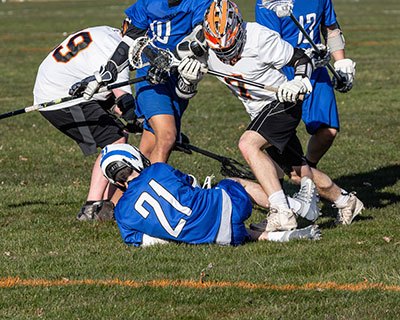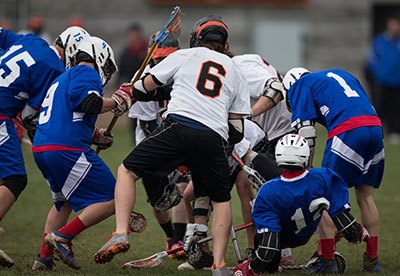Are you a lacrosse player aiming for the perfect game? To get there, you must be aware of its rules and regulations. Unfortunately, the lacrosse illegal procedure penalty is among the most common offenses in lacrosse, and to avoid it, we've prepared this best guide!
Learn all about what constitutes an illegal procedure penalty, how to exclude it, and ultimately guarantee a perfect game by following our foolproof guide.
Read on for more information!
More...
Take away key points:
If you want to learn more about the illegal procedure in the game of lacrosse, refer to the guide below to find the crucial information and perform your best game.
What is an illegal procedure in lacrosse?
Illegal procedures are a huge part of men's lacrosse. These minor infractions are considered technical fouls rather than personal fouls.
A player can commit a technical foul and violate boys' lacrosse rules in different ways, including:
- Having too many players at one end of the field at any time
- Participating in the game when the offensive player goes out of bounds
- A player is in the wrong position during the face-off.

Are illegal procedures personal fouls or technical fouls?
Illegal procedures in lacrosse represent violations of specific rules and can be done by either a single offending player or the whole team. These restrictions count as a technical foul, resulting in less punishment than a personal foul.
The offensive players might touch the ball with their hands, fail to advance, or enter the game from the penalty box before their penalty time ends. However, the illegal procedures include minor restrictions, and the opposing player will have no risk of injuries or aggressive behavior.
Examples of the illegal procedure penalties in lacrosse
Here are some of the most common illegal procedure penalties on the lacrosse field:
- An opposing player throws his stick at another player or a goalie while the game is still going, and does the offense
- A player tries to play without his lacrosse stick
- A player makes contact or holds the ball with his hands during the play
- A player leaving the penalty box before his entire penalty time is up
- There are more than ten players on the lacrosse field
What is the penalty for the illegal procedure?
The penalty for committing an illegal procedure in men's lacrosse varies and depends on the offending team. Under the lacrosse rules, the punishment depends on who possesses the ball when the offending team performs illegal procedures.
If a player commits the penalty on the offense, the other team gets the possession. On the other hand, when the defense team commits a technical foul, the referee will throw a penalty flag. In addition, they will signal a thirty-second releasable penalty assessed to the defense or the team serving the penalty.
Thus, the offending team must play man-down for thirty seconds or until the goal is scored by an opposing player or team.
However, if the foul is committed during a loose ball, possession of the ball will be given to the non-offending team. The same rules apply at the professional lacrosse level of the NCAA men's lacrosse level.
So, the possession of the ball changes during the penalty?
The referee will assign the ball possession to team B if team A commits lacrosse penalties in the offense or during the loose ball sessions.
But if team A is a defensive team and they commit the penalty, they will have to play without a player for the penalty time remaining.
What happens if the opposing team scores the goal?
During a lacrosse game, if the opposing team breaks the rules and commits an illegal procedure penalty, the result is that they score a goal, then the goal will not count.
The referee will blow the whistle, stop the play, and award possession back to the team that was in possession before the illegal procedure. In addition, the player who made the illegal move must leave the playing field for up to one minute.
Depending on the severity of infractions, penalties such as face-offs may be given instead of possession changes as well.
How does a referee signal the illegal procedure penalty?
When a lacrosse official observes a player violates the rules and commits an illegal procedure, the referee throws a flag and stops the play, either at the moment of the penalty or after the possession has changed, depending on who commits the penalty.
The referee will close both fists, rotate them around each other in front of their chest height, and extend their arms. Then, the official will call at their discretion and assess a thirty-second releasable penalty to the wrong team.
Similar penalties to illegal procedure penalties
Below you can find the most similar types of penalties to illegal procedures in lacrosse. These include: stalling the clock, warding, pushing, offsides, interference, and holding.

Stalling the clock
Stalling the clock in lacrosse is difficult for many players to understand or abide by.
According to lacrosse rules, no one can hold or possess the ball for more than a few seconds without attempting to advance it toward the goal.
This technique can be an effective way of stalling and maintaining possession while causing minimal disruption of gameplay.
Warding
In lacrosse, warding is a technique used by defenders to push the opposing player with their hands while gaining possession of the ball.
Warding allows defenders to remain in control of their opponent and prevent them from getting the ball. It is an effective defensive tactic for controlling opponents and keeping the ball away from the opposing team.
Pushing
Pushing in lacrosse is an illegal move, often seen by aggressive players who want to create separation.
Pushing is when a player uses their body to make contact with an opposing player to get past them or prevent and limit their movements. This type of body contact is not legal in lacrosse due to its physical nature, as it can lead to severe injuries.
Offsides
An offside penalty occurs when there are more than a set number of players at the offensive/defensive half of the field at a given time.
This rule prevents teams from having an unfair advantage by overloading one side of their offense and preventing the opposition from getting the ball.
There mustn't be more than six offensive or seven defensive players (goalie included) on the same field end.
Interference
Interference in lacrosse is when an offensive player impedes the movement of a defensive player or uses their body to block the defender's stick. Interference is a foul and results in a stoppage of play.
This infringement can also involve contact unrelated to the ball or assists with the adherence of the offense's prowess. Any player can commit the penalty, including the goalie.
Holding
Lacrosse holding, also known as illegal contact, occurs when a player restrains an opposing player's progress without making enough contact to be considered a foul.
Holding is a situation most commonly encountered by defenders but can also be caused by attackers. It is called both for catching and holding an opponent's stick with one's stick and grasping another player with the hand or body to create space or slow their progress.
Other than this, personal fouls include unsportsmanlike conduct, unnecessary roughness, illegal body checking, and similar penalties.
In addition, they require one-to-three minutes to serve a non-releasable penalty or ejection from the game.
Summary
Although illegal procedures are minor penalties in lacrosse, they cannot hurt opposing teams and players.
The lacrosse illegal procedure penalty is not major as personal fouls, so the only thing that can happen is a warning or loss of possession.
